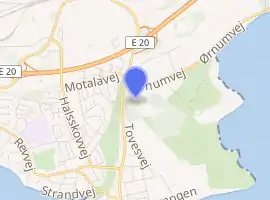Tårnborg
Tårnborg, also spelled Taarnborg, is a former manor house in Korsør, Slagelse Municipality, Denmark. The buildings are now part of Hotel Comwell Grand Park. The Neoclassical main building from 1803 and the manager's house (forpagterboligen) from 1843 were listed on the Danish registry of protected buildings and places in 1982.
| Tårnborg | |
|---|---|

| |
| General information | |
| Architectural style | Neoclassical |
| Location | Tårnborgvej 152, 4220 Korsør |
| Country | Denmark |
| Coordinates | 55°20′45.17″N 11°8′33.54″E |
| Completed | 1803 |
History
Tårnborg was originally the name of a small fortified town whose fortifications were most likely constructed by Svend Grathe in the middle of the 12th century. Tårnborg Castle was after Svend Gratheøs death part of Valdemar I's crown land but lost its military importance when Korsør Castle was built. Tårnborg Castle's home farm (ladegård) was from then on known as Korsør Castle's home farm. In 1458, Christian I allowed the farmers in the new town of Korsør to use the land for grazing in return for the payment of an annual feee. Korsør Castle's home farm was destroyed during the Second Northern War (1657-1660). In 1662, Hugo Lützow proposed to give the land to xitizens of Slagelse who were willing to move to Korsør. The proposal was approved but never realized and the land was a few years later divided between Hugo Lützow (32 tønder hartkorn) and councilman Hans Jørgensen (25 tønder hartkorn). Hans Jørgensen renamed the estate Dyrehovedgård after acquiring Hugo Lützow's share of the land in 1781.[1]
Hans Jørgensen was at the time of his death in 1684 mayor and the wealthiest man in Korsør. Dyrehovedgård changed hands several times over the next decades. In 1709, it was acquired by Ulrich Mogensen. He had previously leased Brahetrolleborg. The land was in 1719 supposed to be returned to the crown for inclusion in Antvorskov Cavalry District but Ulrich Mogensen was after a personal meeting with Frederick IV allowed to keep the estate. It size had at the time of his death grown to 204 tønder hartkorn.[2]
In 1741, Mogensen's widow sold Dyrehovedgård to Poul Hein. He continued the work with expanding the estate through the acquisision of more land. In 1749, it had finally reached the sizer of a "complete manor", or seat (sædegård), meaning that it comprised copyholds with a total area of more than 200 tønder hartkorn, a status that was rewarded with tax exemptions and other privileges.[1]
In 1766, Dyrehovedgaard was acquired by Christian Eggers. In 1774 he purchased one of the nine estates that was sold in public auction when Antvorskov Cavalry District was dissolved. The estate was called Tårnborg after the olf fortification but Eggers instantly renamed it Tårnholm.
Eggers' son Niels Christian Eggers sold Tårnholm one year after his father's death but kept Dyrehovedgård. He was like many other estate owners hit by the economic downturn that followed the state bankruptcy of 1813. In 1821, Dyrehovedgård was taken over by the crown when he was unable to pay his taxes.

In 1823, Dyrehovedgaard and copyholds with a total area of 84 t'nder hartkorn were sold to Christian Ernst Frederik Theill while the remainder of the copyholds was sold to Frederik Adolf Holstein-Holsteinborg. Theill's widow Anna Cathrine Hansen kept the estate when he died the following year. In 1834, she ceded it to their son Andreas Richard Theil.[2]
In 1838, Andreas Richard Theil sold Dyrehovedgaard to Ferdinand Ree from Hamburg. In 1841, Dyrehovedgård changed hands again when the estate was acquired by Valdemar Tully Oxholm. He had close ties to Christian IX by whom he was appointed for the Danish Constituent Assembly and was from 1849 to 1853 a member of Landstinget. In 1846, Oxholm renamed his estate Tårnborg. He increased the size of the estate through land reclamation along the coastline. He convinsed the railway commission that the new Korsør Station should be located on his estate.[2]
In 1866, Oxholm sold Tårnborg to Jørgen Albert Bech. Bech was the brother of August Willads Bech, the owner of nearby Valbygård. Tårnborg was after Jørgen Albert Bech's death passed down to his eldest son Edvard Bech. Most of the farm buildings were destroyed by fire in 1904. This prompted Edvard Bech to sell the estate to the town council. Tårnborg was later sold several times before once again being acquired the Korsør Town Council in 1948.[1]
Today
Taarnborg is today owned by I/S Tårnborg Parkhotel and forms part of Hotel Comwell Grand Park. The Neoclassical main building from 1803 and the manager's house (forpagterboligen) from 1843 were listed on the Danish registry of protected buildings and places in 1982.[3]
List of owners
- ( -1669) The Crown
- (1669-1671) Hugo Lützow
- (1671-1684) Hans Jørgensen
- (1684- ) Jokum Brorsen
- ( -1699) Eiler Jacobsen Eilert
- (1699- ) Christian Schnitler
- ( -1709) Anders Trolle
- (1709- ) Ulrich Mogensen
- ( -1741) Karen Mogensen
- (1741-1766) Poul Hein
- (1766-1793) Christian Eggers
- (1793-1821) Niels Christian Eggers
- (1821-1823) The Crown
- (1823-1824) Christian Ernst Frederik Theill
- (1824-1834) Anna Cathrine Theill, née Hansen
- (1834-1838) Andreas Richard Theill
- (1838-1841) Ferdinand Ree
- (1841-1866) Valdemar Tully Oxholm
- (1866-1876) Jørgen Albert Bech
- (1876-1901) Edvard Bech
- (1901-1904) Korsør Kommune
- (1904-1922) Peter Johansen Flach de Neergaard
- (1922-1935) P. Madelung
- (1922-1935) C.A. Madelung
- (1935-1948) N.V. Jørgensen
- (1948- ) Korsør Kommune
- (2002- ) I/S Tårnborg Parkhotel
References
- "Taarnborg". danskeherregaarde.dk (in Danish). Retrieved 1 October 2019.
- "Tårnborg". roskildehistorie.dk (in Danish). Retrieved 1 October 2019.
- "Sag: Tårnborg". Kulturstyrelsen (in Danish). Retrieved 1 October 2019.